Why Don Coscarelli's Kenny & Company Is The PHANTASM Prequel We Never Got
Before the Tall Man haunted our nightmares, before silver spheres drilled through skulls, and before Mike Pearson ever set foot in Morningside Cemetery, there was another story. A simpler one. A story about autumn leaves, skateboard wheels on suburban pavement, and the first cold touch of mortality on young shoulders.
That story was Kenny & Company (1976), Don Coscarelli's criminally underseen coming-of-age film that stands as the emotional and thematic prequel to Phantasm (1979) even if it was never intended to be.
The Lost Chapter in the Phantasm Universe
While Phantasm phans worldwide can recite the Tall Man's menacing threats and describe the chrome gleam of a Sentinel Sphere in excruciating detail, most have never experienced Kenny & Company. Released three years before Phantasm, this Halloween-set drama follows 12-year-old Kenny and his friends Doug (A. Michael Baldwin) and Sherman through four pivotal autumn days as they navigate bullies, first crushes, and Kenny's beloved dog's death.
20th Century Fox marketed it as a children's movie with the tagline "Have a happy day, Kenny & Company are coming your way" completely missing Coscarelli's intention to create a nostalgic meditation on childhood for adults. It opened in a single test market, Orlando, performed well at matinees but had difficulties in evening screenings, and quickly vanished into the vault. In the U.S., at least. In Japan, it became a phenomenon, with Baldwin, Dan McCann, and Jeff Roth touring to screaming crowds of teenagers.
For decades, Kenny & Company has remained locked in Fox's vault, unavailable for streaming and fetching over $100 on the secondary DVD market. But for those who've seen it, the connection to Phantasm is unmistakable.
Same Faces, Different Fears
The most obvious connection is the cast. A. Michael Baldwin, who plays Doug in Kenny & Company, would become Mike Pearson in Phantasm just three years later. Reggie Bannister, the slightly eccentric teacher Mr. Donovan in Kenny, would transform into Reggie, the ice cream vendor and reluctant hero of the Phantasm franchise.
But it goes deeper than mere casting. Watch Doug in Kenny & Company the precocious kid who talks back to adults, who's fiercely loyal to his friends, who skateboard through autumn streets with the confidence of someone who believes the world is knowable and conquerable. Now watch Mike Pearson in Phantasm the same face, the same intensity, but now haunted by something ineffable. Something that can't be reasoned with or outrun on a skateboard.
The character of Doug feels like Mike Pearson before the Tall Man entered his life. Coscarelli himself has noted that he wrote Mike's role specifically for Baldwin after working with him on Kenny & Company. The director saw something in Baldwin's performance a vulnerability mixed with determination, a child's wonder edged with encroaching maturity —that became the emotional foundation of Phantasm.
Similarly, Mr. Donovan and Reggie share more than an actor. They're both slightly oddball authority figures who treat kids like people rather than problems. Mr. Donovan warns Kenny and Doug about razor blades in Halloween candy with genuine concern, not condescension. Reggie does the same when he becomes Mike's protector and partner against cosmic horror. Both characters exist in that rare space of adults who remember what it felt like to be young and vulnerable.
Here were the direct crossovers:
A. Michael Baldwin: Doug / Mike Pearson
Reggie Bannister Mr. Donovan (schoolteacher) / Reggie
Mary Ellen Shaw Marcy / The Fortune Teller’s Granddaughter
Ralph Richmond Big Doug / Dune’s Cantina Bartender
Kenneth V. Jones (supporting role) / Caretaker
From Childhood to Nightmare
Both films center on children confronting death. In Kenny & Company, death arrives realistically: Kenny's elderly dog is put down, and neither his father nor elderly Mr. Brink can give him a satisfying answer about what comes after. It's quiet, devastating, and real.
Phantasm transforms that grief into horror fantasy. Mike's elaborate nightmare makes death something he can fight the Tall Man personified, defeatable. Kenny & Company is the "before," showing childhood's first encounter with mortality. Phantasm is the "after," where fear becomes actionable and helplessness becomes heroism.
The literal bridge? A haunted house. In Kenny & Company, test audiences loved the Halloween scares. Coscarelli noticed and decided to make horror next. But it's deeper: Kenny ends with boys pranking a spooky house fear as play. Phantasm begins with Mike sneaking around Morningside Cemetery, where the safety disappears and death becomes real.
The Same Universe, Three Years Later
Both films share the same amber-tinted aesthetic shag carpets, autumn light, '70s suburbia where kids roamed until streetlights came on. Coscarelli shot Kenny & Company in his childhood neighborhood with family and friends. For Phantasm, he returned to that visual landscape but filtered it through horror. Same tree-lined streets, same warm light but now they lead to funerals instead of Halloween parties.
Composer Fred Myrow scored both, and the melancholic undercurrent connects them. Both soundtracks understand that beauty and loss are inseparable.
In Phantasm IV, Mike remembers "that last perfect day" before the Tall Man a flashback shot with Kenny & Company's warmth. That's because Kenny IS that last perfect day: skateboarding, laughter, autumn innocence. Then Halloween ends. Three years later, Mike follows his brother to a funeral and enters nightmare.
Additionally, both films were shot on location in and around Long Beach, California, Coscarelli's hometown. (decades before Lana Del Rey would make the city synonymous with melancholic nostalgia) The director knew these streets intimately the tree-lined sidewalks, the modest houses, the way afternoon light filtered through the smog. By returning to the same physical spaces three years later, he transformed familiar neighborhood geography into something uncanny.
Watching It Today
Kenny & Company reframes Phantasm as the second act of Coscarelli's meditation on childhood and death. It explains Mike's fear of losing Jody, the film's emotional core, its dreamlike logic. Most powerfully, it shows us what we lost when the Tall Man arrived: that time when death was distant, Halloween meant candy, and bullies were the scariest thing in the world.
Tragically, Kenny & Company remains nearly impossible to see, trapped in Disney's vault. But every Phantasm phan should seek it out it's not trivia, it's the missing prologue. The chapter where Doug becomes Mike, where childhood exists before cosmic terror crashes through.










